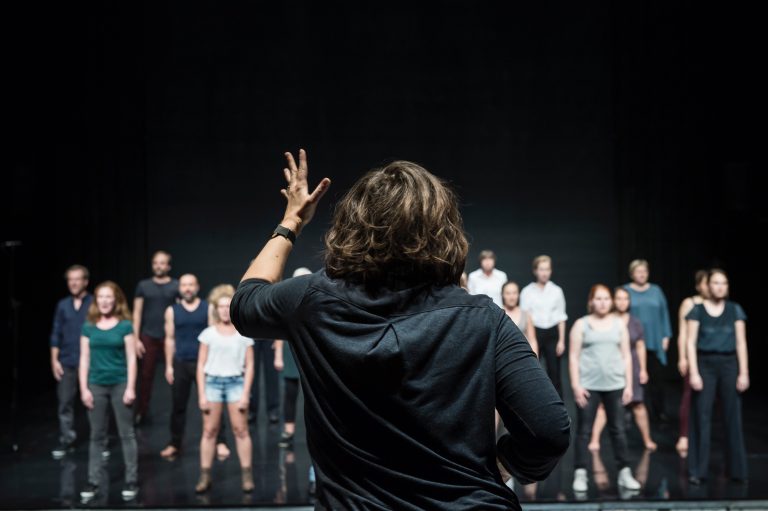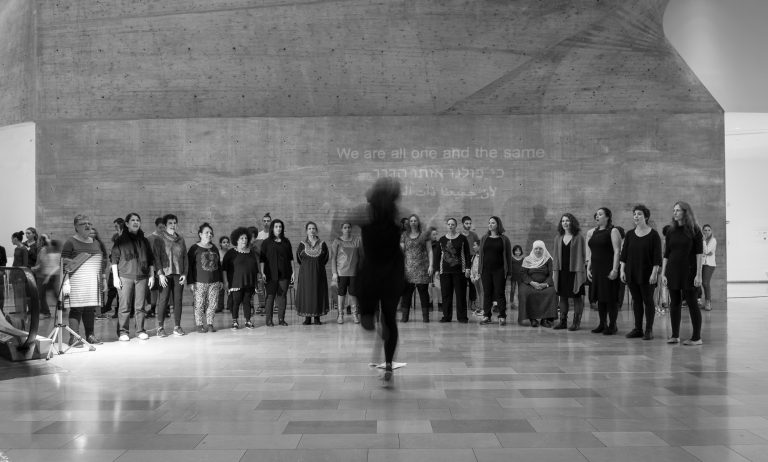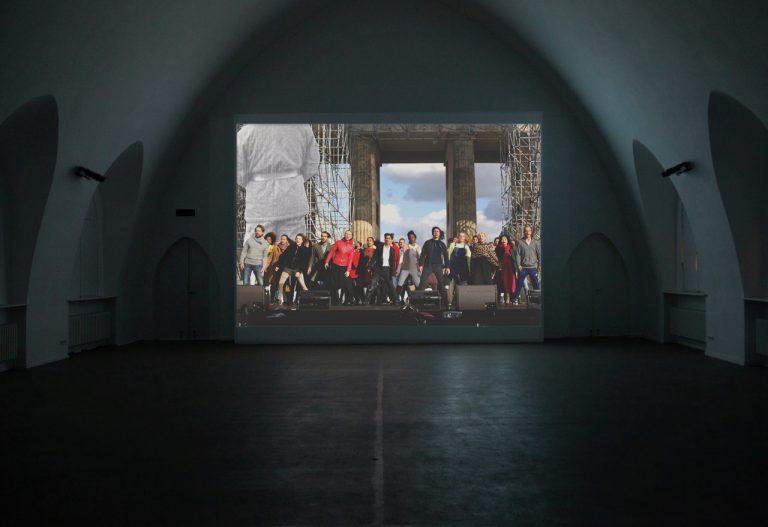MULTITUDE
Marta Górnicka in conversation with Agata Adamiecka
On the occasion of Gallery Weekend Berlin 2020 Ebensperger will present the Polish stage director Marta Górnicka in her first monographic exhibition in a gallery context. The exhibition presents film/sound installations of some of the artist’s most important works, which are well known to the German audiences as the artist has collaborated with German theaters for a number of years. In preparation the theater critic and editor Agata Adamiecka has spoken to Marta Górnicka how this exhibition has developed out of her stage work and how it is related to the current pandemic.

Marta Górnicka, M(other) Courage (Produktionsfoto, Marta Górnicka und Ensemble), Uraufführung 2015 am Staatstheater Braunschweig
Photo © Volker Beinhorn
Courtesy Maxim Gorki Theater
Agata Adamiecka (AA)
Your first monographic exhibition presented at the GALLERY WEEKEND BERLIN with EBENSPERGER gallery is entitled MULTITUDE. How does that term relate to your CHORUS, the formula that you have created and developed over the recent decade?
Marta Górnicka (MG)
Multitude is at the very heart of what the CHORUS is to me. It is its most important principle and the core of its politicality. An instant definition of that term is readily available on Wikipedia, the most popular source for Internet knowledge: multitude is a term from political philosophy which refers to social movements as organisms of individuals acting together. It means a group of people, a PLURALITY which cannot be classified through any other category than its shared existence. Clearly, this refers directly to the basic principle of the CHORUS as the sole protagonist and simultaneously a collective of particular, diverse, varied beings. Since the beginning, the politicality of my CHORUS has relied precisely on that condition of simultaneous collectivity and singularity. I created the CHORUS in furious opposition to contemporary theatre, which understood and staged the CHORUS as a mass of indistinguishable entities. Therefore, for me, MULTITUDE is simply CHORUS, a community of individuals with their individual voices, creating a polyphonic, multidimensional piece in which the body, language and voice articulate each other and themselves, interpenetrate, intertwine. The category of multitude strengthens that kind of thinking, but it also redirects it into new areas and complements it. It emphasizes not so much the inclusion of Others, but the orientation towards what CONNECTS US ALL.
AA
Inclusion assumes a certain hierarchy. We invite Others into our world, we open up to them because we feel that they are allowed to belong. You are proposing a shift which I understand as a more politically radical idea of participation.
Marta Górnicka
That’s right. This is about a true recognition of the fact that we live in the same space, we breathe the same air! After all, the condition that the world is in today does not allow us to delude ourselves any longer that we can cut ourselves off, build a wall, a camp, some place THERE, which will ensure our safety HERE and keep away from all those unsettling Others. Apart from inclusion, we must urgently start thinking in the categories of being-together and participation, of the in-common, of belonging and sharing.
Hence my great need to think about the CHORUS today as a WORKSHOP FOR A NEW SOCIETY – a space where we not so much perform or create a representation of reality, but where we share particular skills and techniques: the breath, the voice, the connections of the breath and the voice and of the voice and the body, bodies and voices with each other, and bodies with technologies which have become part of our hybrid existence. The CHORUS possesses and develops particular techne – like the ancient chorus did. Techne is a set of practical skills which enables the CHORUS’s being-together and facilitates the conscious reworking and communicating the experience of the community in its historical and political contest. The CHORUS should also share these skills. It is from the need to share the CHORUS’s techne that the POLITICAL VOICE INSTITUTE (PVI) at the MAXIM GORKI THEATER in Berlin was born. The PVI consists of 16 performers. Including the impulses of renowned choreographers and sound artists, we have been researching and rehearsing these body/voice techniques in regular workshops at the Gorki Theater. As an artist in residence, I have a strong connection to this house and greatly appreciate the chance to experience such a support and freedom, which is only possible due to the funding of the Kulturstiftung des Bundes, as they not only enable us to do a production but also to realize this laboratory working process. […] I imagine the MULTITUDE CHORUS as a circulatory system which coexists with other systems, bodies, voices, breaths, languages, the air and the earth. A polyphony, a plurality focused on a common goal, internally contradictory and coexistent at the same time. […]
AA
Tell me about the CHORUS’s journey before it finally stood in front of such a defined perspective. Where did you begin?
MG
In early 2010, I started working at the Zbigniew Raszewski Theatre Institute in Warsaw, in an experimental mode. I wanted to create a radically contemporary form of CHORAL theatre; to refresh this old, ancient idea of the theatre and to find a new shape for it. To find a new stage language, a new actor, a new kind of theatrical text for the CHORUS as well as a new type of training – working with the body and voice. I had the opportunity to work and search for the alphabet for the CHORUS in very favorable conditions. We announced a public casting, I chose a group of thirty women of various ages and we put our best foot forward. Six months later, the first public presentation became a premiere. In the following years, we toured the production around the world intensively. My goal was to regain the CHORUS for the theatre and to regain women for the CHORUS, and I completed the task successfully. […] The chorus always constitutes a metonymy of human plurality (pluralitas), and embodies the political tensions and antagonisms existing within it. When a chorus of twenty-five performers enters the stage, with its one body-voice, the ambivalence of the community is immediately set in motion. On the stage, the chorus evokes primeval rituals of being-together, but it also elicits the horror and threat of the community, which consolidates around mechanisms of exclusion and becomes a justification for violence. Today, we are in a desperate need for the ritual aspect of the CHORUS, together with an intensive practice of critical thinking and a space to express the antagonisms. These are extreme and contradictory tasks – but choral theatre opens up the possibility for such work.

Production photo: © Yair Mexuhas
Courtesy Ebensperger, Berlin/Wien
AA
With time, the formula and idea of the CHORUS that you developed in the theatre was becoming a more radical political practice. The CHORUS was regularly summoned in spaces of conflict, in excluded communities, in public spaces. It even reached for legal documents of the highest order, around which heated political arguments were centered at that time.
MG
The CHORUS began entering political hotspots. In Israel, it was in the middle of a warzone. In Slovakia, it was in the middle of the largest Romani ghetto in the world. In Poland – at the moment of the greatest political impasse around its Constitution – it was on Warsaw’s central square Plac Defilad.
In Israel, it was about meeting groups which existed in a situation of a deadly conflict and trying to show that your opponent does not have to be your enemy. That not every fight, every difference of opinion or every harsh word has to lead to eliminating the opponent. We staged a performance with a sixty-people CHORUS of Arab and Jewish mothers, Israeli dancer-soldiers, and Arab children, scored for four spaces in the MUSEUM OF MODERN ART in Tel Aviv. MOTHER COURAGE WON’T REMAIN SILENT. THE CHORUS FOR WAR TIME was in principle a chorus of two tongues (Arabic and Hebrew) and one voice. I gathered people who had no contact with each other in their daily lives, and remained divided by an invisible barrier. The CHORUS showed the body of the military conflict through individual biographies, voices, fractures, tensions, but also laughter. The body of the soldier was juxtaposed with the bodies of a woman and a child. “EVERYBODY here is an enemy. We just don’t know what it means that EVERYBODY is an enemy. WE DON’T KNOW WHO IS WHO.” […]
After the 2015 general elections in Poland, when the far-right, nationalist party Law and Justice rose to power, I reacted very emotionally by swiftly creating a CHORUS OF POLES in Nowy Teatr in Warsaw. I wanted to gather both sides of the political conflict on the stage as well as those who were being cynically exploited in that conflict. In CONSTITUTION FOR THE CHORUS OF POLES, they were refugees from Chechnya, immigrants, members of minorities, Jewish people, football fans. This was not about sounding in unison, but precisely about making introductions between people whose opinions could not be reconciled in any way. Even then, it was already difficult. This performance was first presented on 1 May 2016, on International Workers’ Day, at the heart of the national debate sparked by the turmoil around the Constitutional Tribunal. I go wherever antagonized communities have no more room to breathe. I want them to regain the right to their common good – to their language, their air, their past, to living together on Earth. In these cases, the situation of political tension awakened the need to GATHER. The most important and most difficult part of this process is always gathering the CHORUS, which is a multitude. Building a common voice which is both individualized and collective is also very difficult. […]
AA
Of course, rather than being the cause of the current crisis, the pandemic is only a symptom of the state that the world has already been in. And it hit the CHORUS right in its heart. Will the CHORUS stay silent and keep a safe distance at this moment in time?
MG
For me, the pandemic is the end of an era and a symbolic death of the CHORUS. There is no real community without living breaths, there is no humanity without living bodies being together, there is no CHORUS without the breath – which is universal/common to the audience member and the performer. Therefore, there is no theatre if we cannot breathe and talk in it together. We are standing on the debris of the community / the theatre.
The answer to the death of the COMMUNITY/ CHORUS is the ONE PERSON CHORUS. DIGITAL/RITUAL. DEFUSED. The CHORUS stops speaking in the literal sense. But it starts lip-syncing, uses technology which imitates voice, plays with the (non-)living voice, with distanced bodies and language, but it also multiplies its individual voice, turns the voice up to full volume! It is a CHORUS which functions somewhere between speaking and not speaking (like lip-syncing), but it is not silent. From one person, it grows into a multitude, it works with shreds, trash, key words, fragments of mythological songs and voices from computer games. It works with the scream, which comes from the very heart of the ritual, and with the digital laughter, which is its most powerful tool. This CHORUS plunges into death, but it still speaks in favor of life.
In Die Welt, German virologists warn us that choir rehearsals and weddings are the most dangerous forms of being together, of meeting. Scientists generally caution against all forms of GATHERING. Therefore, instead of the CHORUS, we now have a ONE PERSON CHORUS. Instead of SOCIETY: CHORUS – AN APP FOR ONE PERSON.

Installation view, Marta Górnicka, Grundgesetz, 2018 in the exhibition “Multitude” by Ebensperger at Luxoom Lab
Courtesy Ebensperger, Berlin/Wien
As an answer to the pandemic, but also to the diagnosis from before the pandemic, the CHORUS multiplies its voice and, speaking like a cartoon character, it lip-syncs: THE CHORUS NEVER DIES! – but it is already speaking as a one-man/one-woman chorus. This is because we are stuck in a profoundly paradoxical situation. How can we rebuild the world of relationships outside relationships? How can we re-tie our bonds outside of bonds? How can we find a shared breath without air?
So, when you are asking me whether the CHORUS still exists, I say: no. THERE IS NO MORE CHORUS. There is CHORUS – AN APP FOR ONE PERSON.
This paradoxical situation is described perfectly by the ambiguous Hebrew word magrepha, which literally means a scoop or shovel. In the Talmud, it is used in different contexts related to the Temple of Jerusalem. First, the mysterious magrepha is thought to have been a pipe organ at the Temple. Each of its ten pipes made one hundred different sounds, and so the instrument vibrated with a thousand voices. At the same time, an object called magrepha was also used to scoop ashes from the sacrificial offerings burnt at the altar and – as explained by Rabbi Shapiro in his laconic, but moving speech – to collect the ashes from the bodies of Jewish people. The magrepha – a tool for gathering the ashes of the dead and a musical instrument of a thousand voices – plays the loudest music of all. This is the condition of the CHORUS today.
What we have left is the vibration of the voice, its trembling, which connects us to other beings and all people, and with the entire universe. Therefore, what we can do today is to engage in the practice of being together, in common. As a workshop of the VOICE, a workshop conducted in small groups, but with no masks, and the entire body engaged. From the death of the CHORUS to the WORKSHOP FOR THE NEW SOCIETY.
